Health Determinant Analysis: Impact of Poverty on Health in Australia
VerifiedAdded on 2023/01/16
|10
|3672
|80
Report
AI Summary
This report examines the intricate relationship between poverty and health, specifically focusing on the Australian context. It identifies income and social status as major determinants, exploring how economic conditions, including inflation, unemployment, and education levels, directly influence health outcomes. The analysis delves into the impact of low income on diet, mental health, and child development, highlighting the inequalities arising from class differences and unequal resource distribution. The report references various studies and emphasizes the role of government in ensuring equitable access to health resources. It investigates the consequences of poverty, such as malnutrition and psychological distress, and underscores the need for economic improvements to positively impact health. The literature review supports the arguments by discussing a healthy diet, mental stress and the class difference in the Australian population.
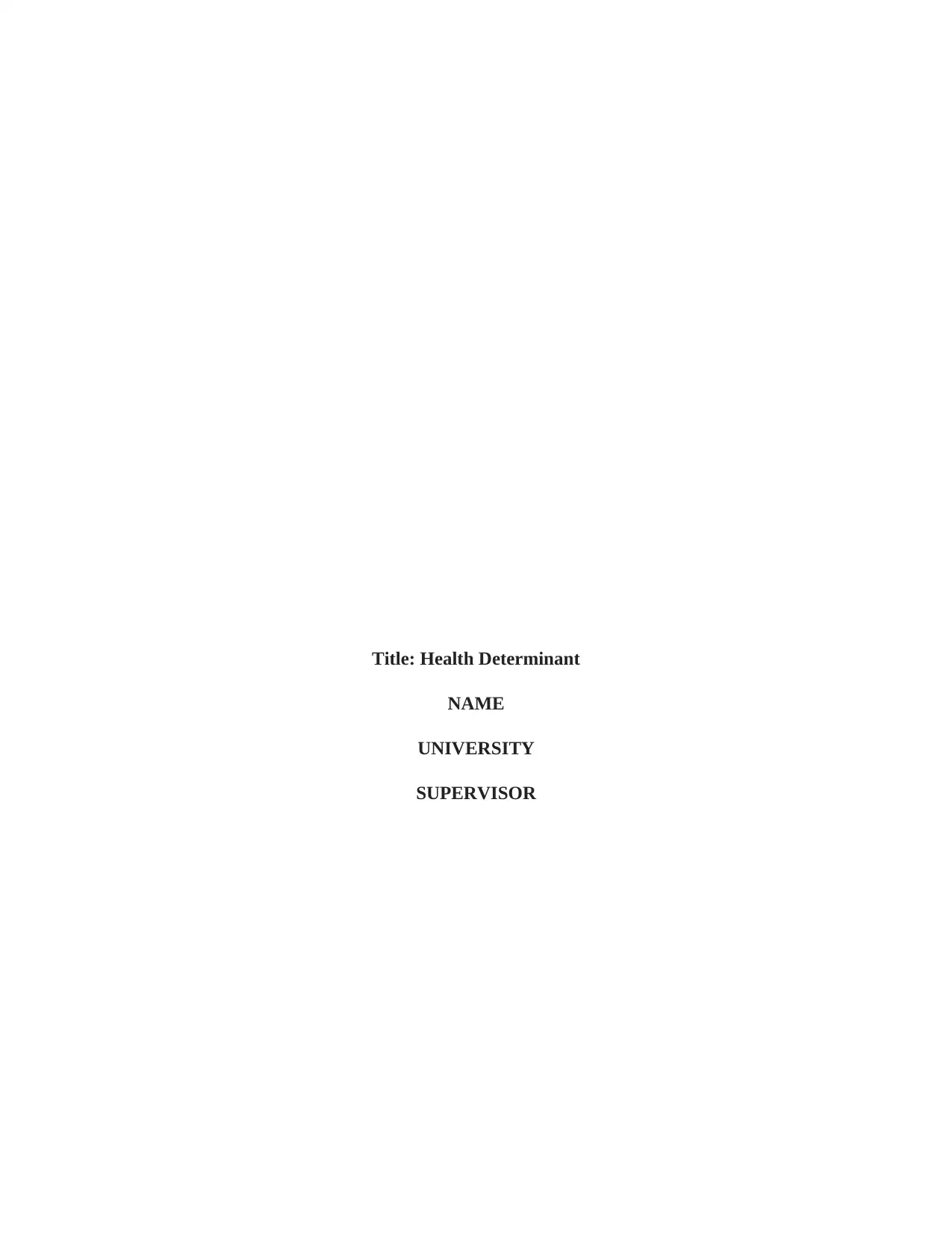
Title: Health Determinant
NAME
UNIVERSITY
SUPERVISOR
NAME
UNIVERSITY
SUPERVISOR
Paraphrase This Document
Need a fresh take? Get an instant paraphrase of this document with our AI Paraphraser
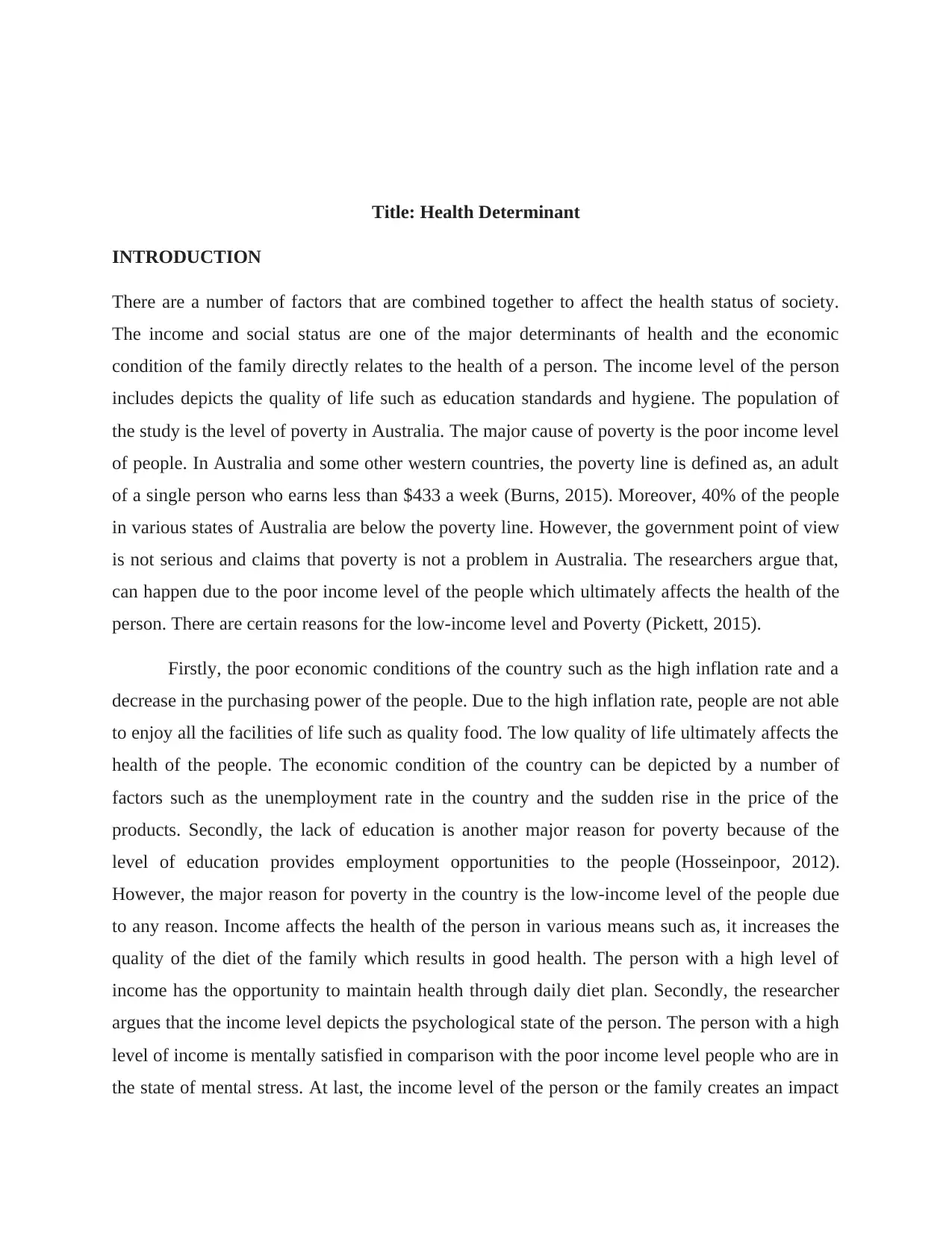
Title: Health Determinant
INTRODUCTION
There are a number of factors that are combined together to affect the health status of society.
The income and social status are one of the major determinants of health and the economic
condition of the family directly relates to the health of a person. The income level of the person
includes depicts the quality of life such as education standards and hygiene. The population of
the study is the level of poverty in Australia. The major cause of poverty is the poor income level
of people. In Australia and some other western countries, the poverty line is defined as, an adult
of a single person who earns less than $433 a week (Burns, 2015). Moreover, 40% of the people
in various states of Australia are below the poverty line. However, the government point of view
is not serious and claims that poverty is not a problem in Australia. The researchers argue that,
can happen due to the poor income level of the people which ultimately affects the health of the
person. There are certain reasons for the low-income level and Poverty (Pickett, 2015).
Firstly, the poor economic conditions of the country such as the high inflation rate and a
decrease in the purchasing power of the people. Due to the high inflation rate, people are not able
to enjoy all the facilities of life such as quality food. The low quality of life ultimately affects the
health of the people. The economic condition of the country can be depicted by a number of
factors such as the unemployment rate in the country and the sudden rise in the price of the
products. Secondly, the lack of education is another major reason for poverty because of the
level of education provides employment opportunities to the people (Hosseinpoor, 2012).
However, the major reason for poverty in the country is the low-income level of the people due
to any reason. Income affects the health of the person in various means such as, it increases the
quality of the diet of the family which results in good health. The person with a high level of
income has the opportunity to maintain health through daily diet plan. Secondly, the researcher
argues that the income level depicts the psychological state of the person. The person with a high
level of income is mentally satisfied in comparison with the poor income level people who are in
the state of mental stress. At last, the income level of the person or the family creates an impact
INTRODUCTION
There are a number of factors that are combined together to affect the health status of society.
The income and social status are one of the major determinants of health and the economic
condition of the family directly relates to the health of a person. The income level of the person
includes depicts the quality of life such as education standards and hygiene. The population of
the study is the level of poverty in Australia. The major cause of poverty is the poor income level
of people. In Australia and some other western countries, the poverty line is defined as, an adult
of a single person who earns less than $433 a week (Burns, 2015). Moreover, 40% of the people
in various states of Australia are below the poverty line. However, the government point of view
is not serious and claims that poverty is not a problem in Australia. The researchers argue that,
can happen due to the poor income level of the people which ultimately affects the health of the
person. There are certain reasons for the low-income level and Poverty (Pickett, 2015).
Firstly, the poor economic conditions of the country such as the high inflation rate and a
decrease in the purchasing power of the people. Due to the high inflation rate, people are not able
to enjoy all the facilities of life such as quality food. The low quality of life ultimately affects the
health of the people. The economic condition of the country can be depicted by a number of
factors such as the unemployment rate in the country and the sudden rise in the price of the
products. Secondly, the lack of education is another major reason for poverty because of the
level of education provides employment opportunities to the people (Hosseinpoor, 2012).
However, the major reason for poverty in the country is the low-income level of the people due
to any reason. Income affects the health of the person in various means such as, it increases the
quality of the diet of the family which results in good health. The person with a high level of
income has the opportunity to maintain health through daily diet plan. Secondly, the researcher
argues that the income level depicts the psychological state of the person. The person with a high
level of income is mentally satisfied in comparison with the poor income level people who are in
the state of mental stress. At last, the income level of the person or the family creates an impact
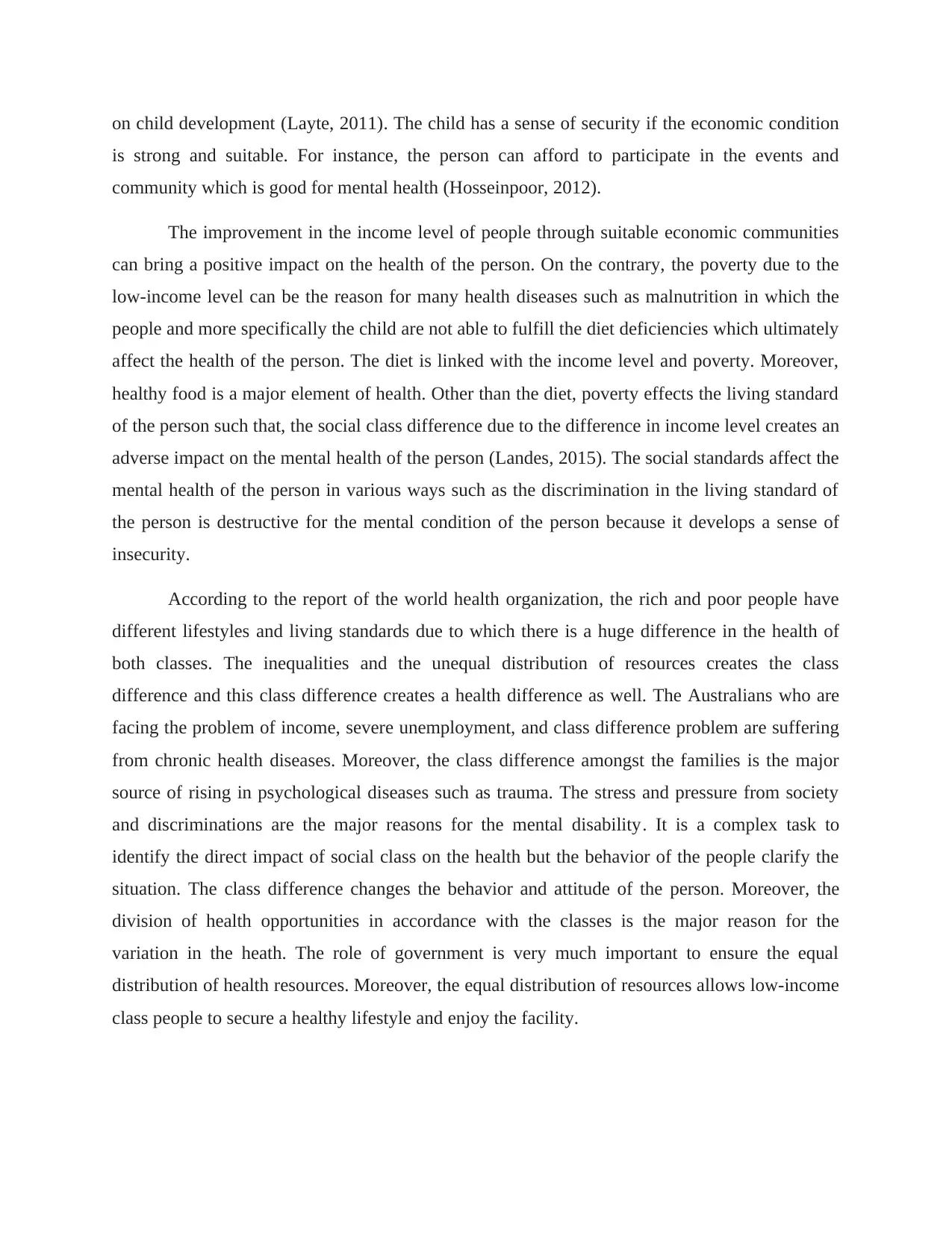
on child development (Layte, 2011). The child has a sense of security if the economic condition
is strong and suitable. For instance, the person can afford to participate in the events and
community which is good for mental health (Hosseinpoor, 2012).
The improvement in the income level of people through suitable economic communities
can bring a positive impact on the health of the person. On the contrary, the poverty due to the
low-income level can be the reason for many health diseases such as malnutrition in which the
people and more specifically the child are not able to fulfill the diet deficiencies which ultimately
affect the health of the person. The diet is linked with the income level and poverty. Moreover,
healthy food is a major element of health. Other than the diet, poverty effects the living standard
of the person such that, the social class difference due to the difference in income level creates an
adverse impact on the mental health of the person (Landes, 2015). The social standards affect the
mental health of the person in various ways such as the discrimination in the living standard of
the person is destructive for the mental condition of the person because it develops a sense of
insecurity.
According to the report of the world health organization, the rich and poor people have
different lifestyles and living standards due to which there is a huge difference in the health of
both classes. The inequalities and the unequal distribution of resources creates the class
difference and this class difference creates a health difference as well. The Australians who are
facing the problem of income, severe unemployment, and class difference problem are suffering
from chronic health diseases. Moreover, the class difference amongst the families is the major
source of rising in psychological diseases such as trauma. The stress and pressure from society
and discriminations are the major reasons for the mental disability. It is a complex task to
identify the direct impact of social class on the health but the behavior of the people clarify the
situation. The class difference changes the behavior and attitude of the person. Moreover, the
division of health opportunities in accordance with the classes is the major reason for the
variation in the heath. The role of government is very much important to ensure the equal
distribution of health resources. Moreover, the equal distribution of resources allows low-income
class people to secure a healthy lifestyle and enjoy the facility.
is strong and suitable. For instance, the person can afford to participate in the events and
community which is good for mental health (Hosseinpoor, 2012).
The improvement in the income level of people through suitable economic communities
can bring a positive impact on the health of the person. On the contrary, the poverty due to the
low-income level can be the reason for many health diseases such as malnutrition in which the
people and more specifically the child are not able to fulfill the diet deficiencies which ultimately
affect the health of the person. The diet is linked with the income level and poverty. Moreover,
healthy food is a major element of health. Other than the diet, poverty effects the living standard
of the person such that, the social class difference due to the difference in income level creates an
adverse impact on the mental health of the person (Landes, 2015). The social standards affect the
mental health of the person in various ways such as the discrimination in the living standard of
the person is destructive for the mental condition of the person because it develops a sense of
insecurity.
According to the report of the world health organization, the rich and poor people have
different lifestyles and living standards due to which there is a huge difference in the health of
both classes. The inequalities and the unequal distribution of resources creates the class
difference and this class difference creates a health difference as well. The Australians who are
facing the problem of income, severe unemployment, and class difference problem are suffering
from chronic health diseases. Moreover, the class difference amongst the families is the major
source of rising in psychological diseases such as trauma. The stress and pressure from society
and discriminations are the major reasons for the mental disability. It is a complex task to
identify the direct impact of social class on the health but the behavior of the people clarify the
situation. The class difference changes the behavior and attitude of the person. Moreover, the
division of health opportunities in accordance with the classes is the major reason for the
variation in the heath. The role of government is very much important to ensure the equal
distribution of health resources. Moreover, the equal distribution of resources allows low-income
class people to secure a healthy lifestyle and enjoy the facility.
⊘ This is a preview!⊘
Do you want full access?
Subscribe today to unlock all pages.

Trusted by 1+ million students worldwide
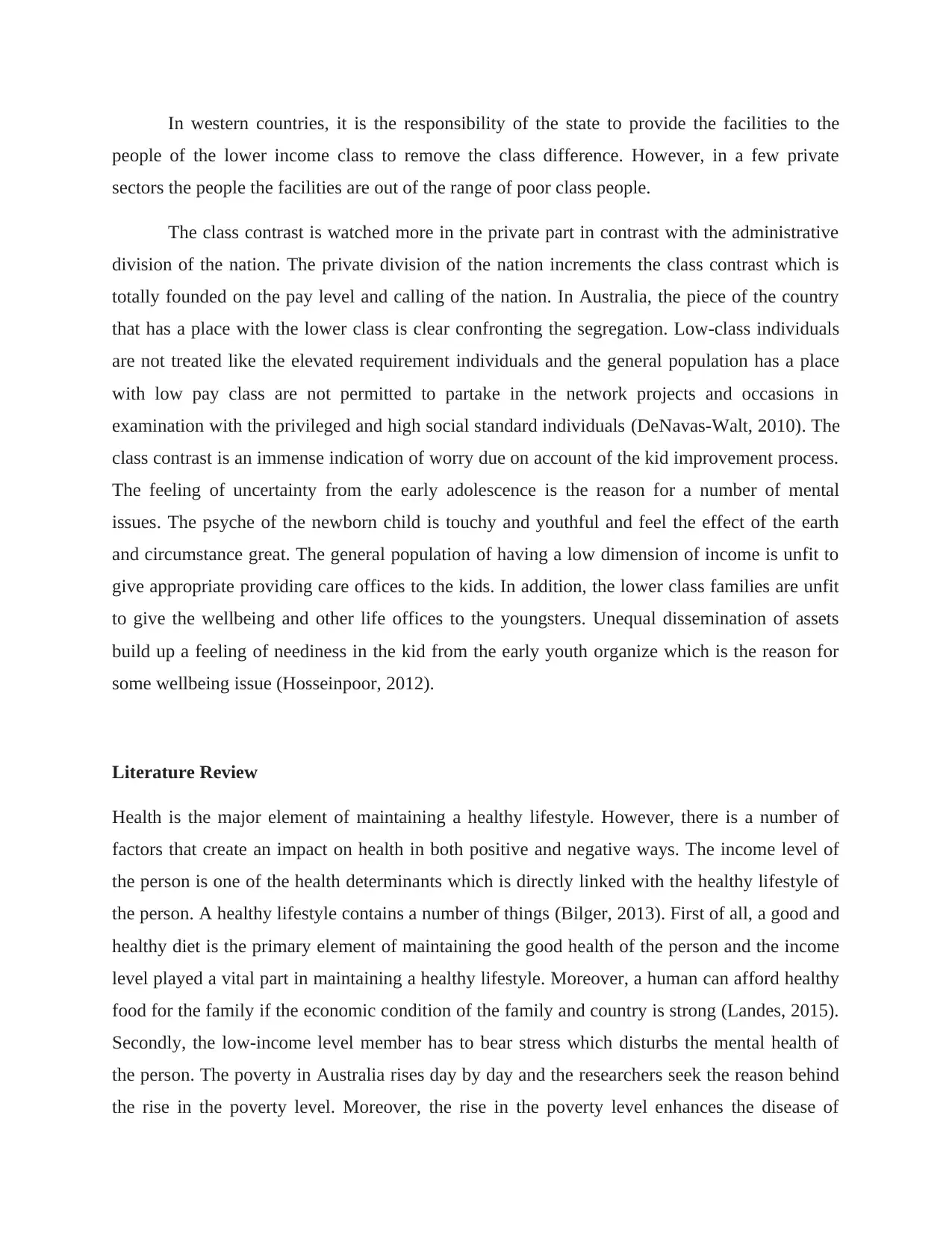
In western countries, it is the responsibility of the state to provide the facilities to the
people of the lower income class to remove the class difference. However, in a few private
sectors the people the facilities are out of the range of poor class people.
The class contrast is watched more in the private part in contrast with the administrative
division of the nation. The private division of the nation increments the class contrast which is
totally founded on the pay level and calling of the nation. In Australia, the piece of the country
that has a place with the lower class is clear confronting the segregation. Low-class individuals
are not treated like the elevated requirement individuals and the general population has a place
with low pay class are not permitted to partake in the network projects and occasions in
examination with the privileged and high social standard individuals (DeNavas-Walt, 2010). The
class contrast is an immense indication of worry due on account of the kid improvement process.
The feeling of uncertainty from the early adolescence is the reason for a number of mental
issues. The psyche of the newborn child is touchy and youthful and feel the effect of the earth
and circumstance great. The general population of having a low dimension of income is unfit to
give appropriate providing care offices to the kids. In addition, the lower class families are unfit
to give the wellbeing and other life offices to the youngsters. Unequal dissemination of assets
build up a feeling of neediness in the kid from the early youth organize which is the reason for
some wellbeing issue (Hosseinpoor, 2012).
Literature Review
Health is the major element of maintaining a healthy lifestyle. However, there is a number of
factors that create an impact on health in both positive and negative ways. The income level of
the person is one of the health determinants which is directly linked with the healthy lifestyle of
the person. A healthy lifestyle contains a number of things (Bilger, 2013). First of all, a good and
healthy diet is the primary element of maintaining the good health of the person and the income
level played a vital part in maintaining a healthy lifestyle. Moreover, a human can afford healthy
food for the family if the economic condition of the family and country is strong (Landes, 2015).
Secondly, the low-income level member has to bear stress which disturbs the mental health of
the person. The poverty in Australia rises day by day and the researchers seek the reason behind
the rise in the poverty level. Moreover, the rise in the poverty level enhances the disease of
people of the lower income class to remove the class difference. However, in a few private
sectors the people the facilities are out of the range of poor class people.
The class contrast is watched more in the private part in contrast with the administrative
division of the nation. The private division of the nation increments the class contrast which is
totally founded on the pay level and calling of the nation. In Australia, the piece of the country
that has a place with the lower class is clear confronting the segregation. Low-class individuals
are not treated like the elevated requirement individuals and the general population has a place
with low pay class are not permitted to partake in the network projects and occasions in
examination with the privileged and high social standard individuals (DeNavas-Walt, 2010). The
class contrast is an immense indication of worry due on account of the kid improvement process.
The feeling of uncertainty from the early adolescence is the reason for a number of mental
issues. The psyche of the newborn child is touchy and youthful and feel the effect of the earth
and circumstance great. The general population of having a low dimension of income is unfit to
give appropriate providing care offices to the kids. In addition, the lower class families are unfit
to give the wellbeing and other life offices to the youngsters. Unequal dissemination of assets
build up a feeling of neediness in the kid from the early youth organize which is the reason for
some wellbeing issue (Hosseinpoor, 2012).
Literature Review
Health is the major element of maintaining a healthy lifestyle. However, there is a number of
factors that create an impact on health in both positive and negative ways. The income level of
the person is one of the health determinants which is directly linked with the healthy lifestyle of
the person. A healthy lifestyle contains a number of things (Bilger, 2013). First of all, a good and
healthy diet is the primary element of maintaining the good health of the person and the income
level played a vital part in maintaining a healthy lifestyle. Moreover, a human can afford healthy
food for the family if the economic condition of the family and country is strong (Landes, 2015).
Secondly, the low-income level member has to bear stress which disturbs the mental health of
the person. The poverty in Australia rises day by day and the researchers seek the reason behind
the rise in the poverty level. Moreover, the rise in the poverty level enhances the disease of
Paraphrase This Document
Need a fresh take? Get an instant paraphrase of this document with our AI Paraphraser
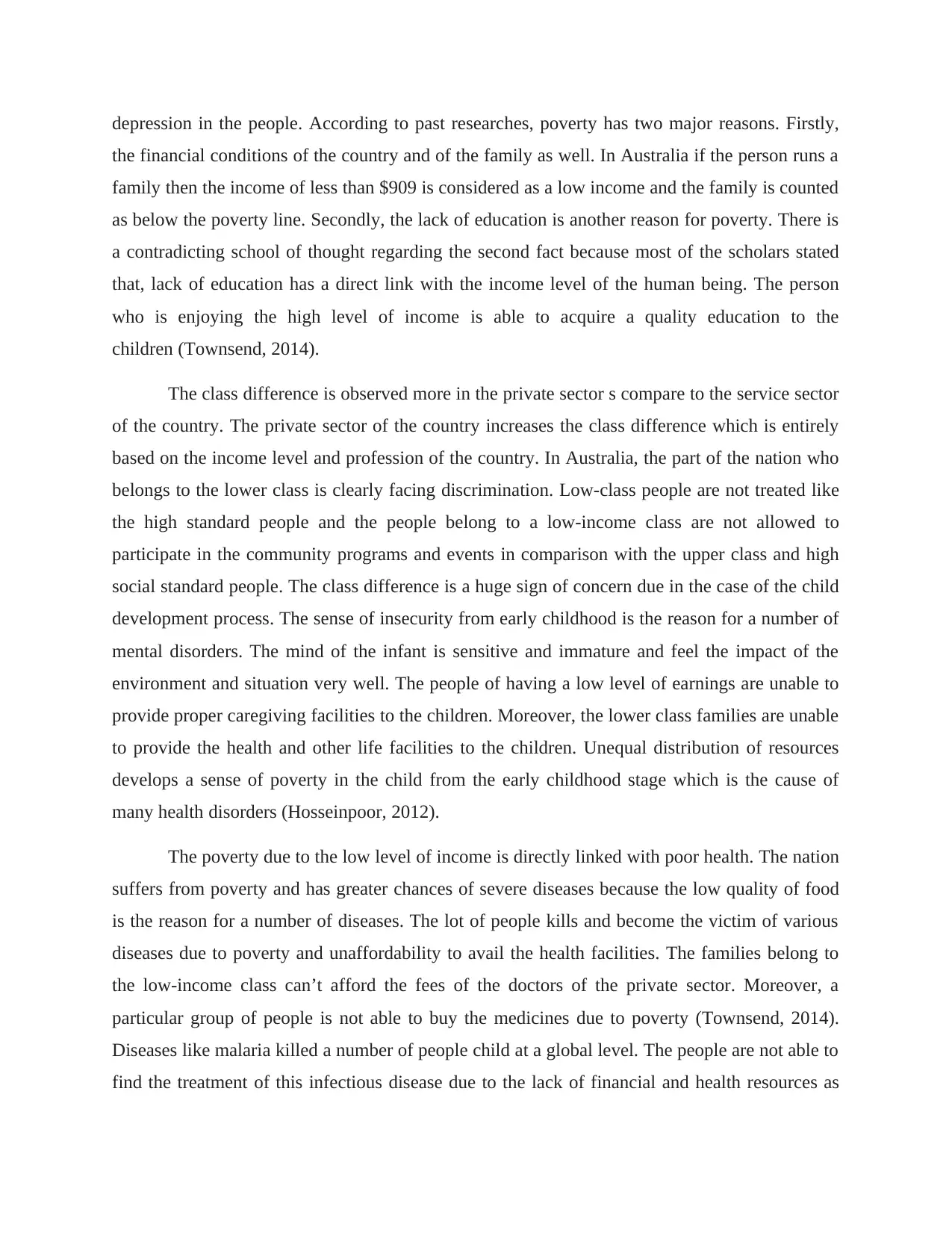
depression in the people. According to past researches, poverty has two major reasons. Firstly,
the financial conditions of the country and of the family as well. In Australia if the person runs a
family then the income of less than $909 is considered as a low income and the family is counted
as below the poverty line. Secondly, the lack of education is another reason for poverty. There is
a contradicting school of thought regarding the second fact because most of the scholars stated
that, lack of education has a direct link with the income level of the human being. The person
who is enjoying the high level of income is able to acquire a quality education to the
children (Townsend, 2014).
The class difference is observed more in the private sector s compare to the service sector
of the country. The private sector of the country increases the class difference which is entirely
based on the income level and profession of the country. In Australia, the part of the nation who
belongs to the lower class is clearly facing discrimination. Low-class people are not treated like
the high standard people and the people belong to a low-income class are not allowed to
participate in the community programs and events in comparison with the upper class and high
social standard people. The class difference is a huge sign of concern due in the case of the child
development process. The sense of insecurity from early childhood is the reason for a number of
mental disorders. The mind of the infant is sensitive and immature and feel the impact of the
environment and situation very well. The people of having a low level of earnings are unable to
provide proper caregiving facilities to the children. Moreover, the lower class families are unable
to provide the health and other life facilities to the children. Unequal distribution of resources
develops a sense of poverty in the child from the early childhood stage which is the cause of
many health disorders (Hosseinpoor, 2012).
The poverty due to the low level of income is directly linked with poor health. The nation
suffers from poverty and has greater chances of severe diseases because the low quality of food
is the reason for a number of diseases. The lot of people kills and become the victim of various
diseases due to poverty and unaffordability to avail the health facilities. The families belong to
the low-income class can’t afford the fees of the doctors of the private sector. Moreover, a
particular group of people is not able to buy the medicines due to poverty (Townsend, 2014).
Diseases like malaria killed a number of people child at a global level. The people are not able to
find the treatment of this infectious disease due to the lack of financial and health resources as
the financial conditions of the country and of the family as well. In Australia if the person runs a
family then the income of less than $909 is considered as a low income and the family is counted
as below the poverty line. Secondly, the lack of education is another reason for poverty. There is
a contradicting school of thought regarding the second fact because most of the scholars stated
that, lack of education has a direct link with the income level of the human being. The person
who is enjoying the high level of income is able to acquire a quality education to the
children (Townsend, 2014).
The class difference is observed more in the private sector s compare to the service sector
of the country. The private sector of the country increases the class difference which is entirely
based on the income level and profession of the country. In Australia, the part of the nation who
belongs to the lower class is clearly facing discrimination. Low-class people are not treated like
the high standard people and the people belong to a low-income class are not allowed to
participate in the community programs and events in comparison with the upper class and high
social standard people. The class difference is a huge sign of concern due in the case of the child
development process. The sense of insecurity from early childhood is the reason for a number of
mental disorders. The mind of the infant is sensitive and immature and feel the impact of the
environment and situation very well. The people of having a low level of earnings are unable to
provide proper caregiving facilities to the children. Moreover, the lower class families are unable
to provide the health and other life facilities to the children. Unequal distribution of resources
develops a sense of poverty in the child from the early childhood stage which is the cause of
many health disorders (Hosseinpoor, 2012).
The poverty due to the low level of income is directly linked with poor health. The nation
suffers from poverty and has greater chances of severe diseases because the low quality of food
is the reason for a number of diseases. The lot of people kills and become the victim of various
diseases due to poverty and unaffordability to avail the health facilities. The families belong to
the low-income class can’t afford the fees of the doctors of the private sector. Moreover, a
particular group of people is not able to buy the medicines due to poverty (Townsend, 2014).
Diseases like malaria killed a number of people child at a global level. The people are not able to
find the treatment of this infectious disease due to the lack of financial and health resources as
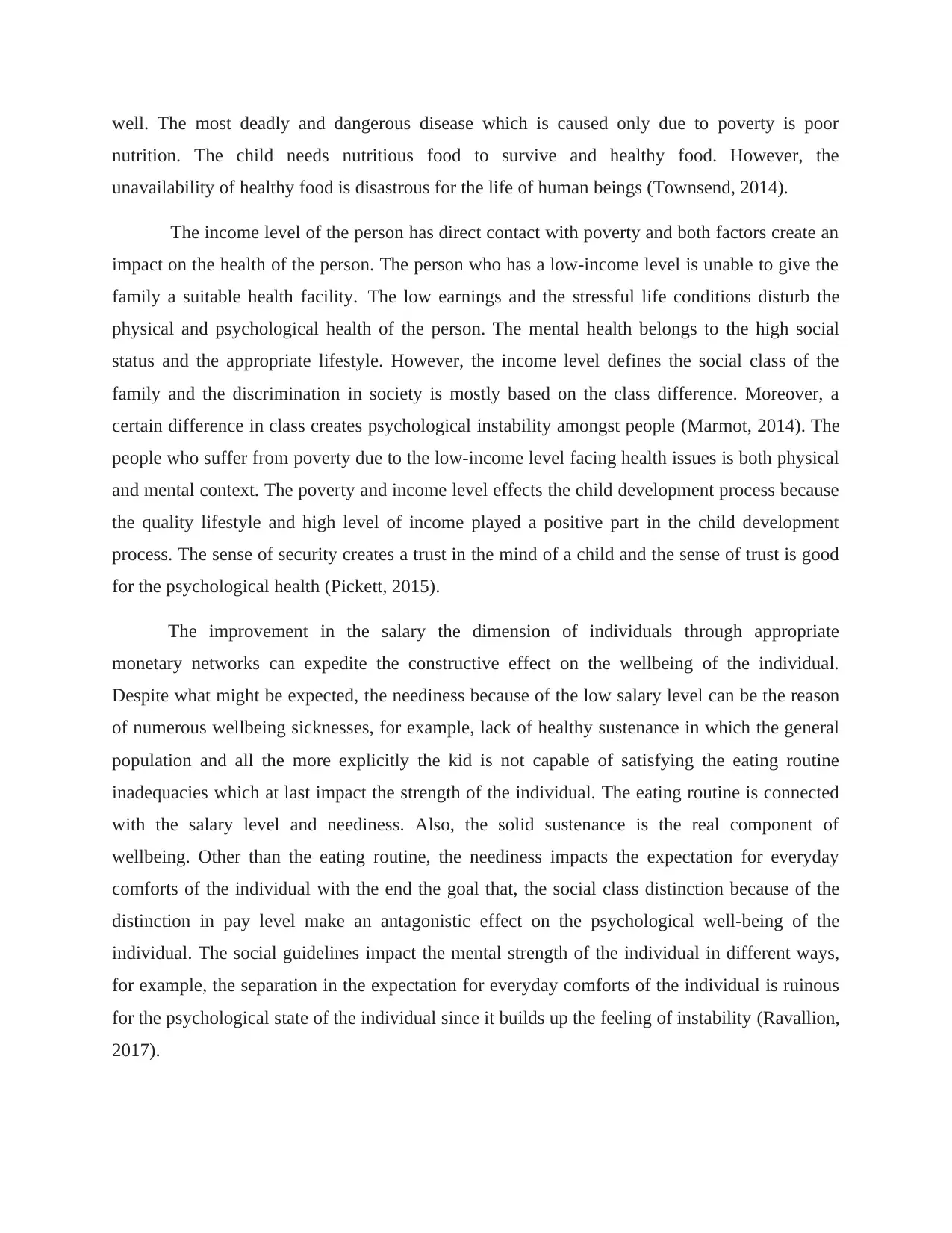
well. The most deadly and dangerous disease which is caused only due to poverty is poor
nutrition. The child needs nutritious food to survive and healthy food. However, the
unavailability of healthy food is disastrous for the life of human beings (Townsend, 2014).
The income level of the person has direct contact with poverty and both factors create an
impact on the health of the person. The person who has a low-income level is unable to give the
family a suitable health facility. The low earnings and the stressful life conditions disturb the
physical and psychological health of the person. The mental health belongs to the high social
status and the appropriate lifestyle. However, the income level defines the social class of the
family and the discrimination in society is mostly based on the class difference. Moreover, a
certain difference in class creates psychological instability amongst people (Marmot, 2014). The
people who suffer from poverty due to the low-income level facing health issues is both physical
and mental context. The poverty and income level effects the child development process because
the quality lifestyle and high level of income played a positive part in the child development
process. The sense of security creates a trust in the mind of a child and the sense of trust is good
for the psychological health (Pickett, 2015).
The improvement in the salary the dimension of individuals through appropriate
monetary networks can expedite the constructive effect on the wellbeing of the individual.
Despite what might be expected, the neediness because of the low salary level can be the reason
of numerous wellbeing sicknesses, for example, lack of healthy sustenance in which the general
population and all the more explicitly the kid is not capable of satisfying the eating routine
inadequacies which at last impact the strength of the individual. The eating routine is connected
with the salary level and neediness. Also, the solid sustenance is the real component of
wellbeing. Other than the eating routine, the neediness impacts the expectation for everyday
comforts of the individual with the end the goal that, the social class distinction because of the
distinction in pay level make an antagonistic effect on the psychological well-being of the
individual. The social guidelines impact the mental strength of the individual in different ways,
for example, the separation in the expectation for everyday comforts of the individual is ruinous
for the psychological state of the individual since it builds up the feeling of instability (Ravallion,
2017).
nutrition. The child needs nutritious food to survive and healthy food. However, the
unavailability of healthy food is disastrous for the life of human beings (Townsend, 2014).
The income level of the person has direct contact with poverty and both factors create an
impact on the health of the person. The person who has a low-income level is unable to give the
family a suitable health facility. The low earnings and the stressful life conditions disturb the
physical and psychological health of the person. The mental health belongs to the high social
status and the appropriate lifestyle. However, the income level defines the social class of the
family and the discrimination in society is mostly based on the class difference. Moreover, a
certain difference in class creates psychological instability amongst people (Marmot, 2014). The
people who suffer from poverty due to the low-income level facing health issues is both physical
and mental context. The poverty and income level effects the child development process because
the quality lifestyle and high level of income played a positive part in the child development
process. The sense of security creates a trust in the mind of a child and the sense of trust is good
for the psychological health (Pickett, 2015).
The improvement in the salary the dimension of individuals through appropriate
monetary networks can expedite the constructive effect on the wellbeing of the individual.
Despite what might be expected, the neediness because of the low salary level can be the reason
of numerous wellbeing sicknesses, for example, lack of healthy sustenance in which the general
population and all the more explicitly the kid is not capable of satisfying the eating routine
inadequacies which at last impact the strength of the individual. The eating routine is connected
with the salary level and neediness. Also, the solid sustenance is the real component of
wellbeing. Other than the eating routine, the neediness impacts the expectation for everyday
comforts of the individual with the end the goal that, the social class distinction because of the
distinction in pay level make an antagonistic effect on the psychological well-being of the
individual. The social guidelines impact the mental strength of the individual in different ways,
for example, the separation in the expectation for everyday comforts of the individual is ruinous
for the psychological state of the individual since it builds up the feeling of instability (Ravallion,
2017).
⊘ This is a preview!⊘
Do you want full access?
Subscribe today to unlock all pages.

Trusted by 1+ million students worldwide
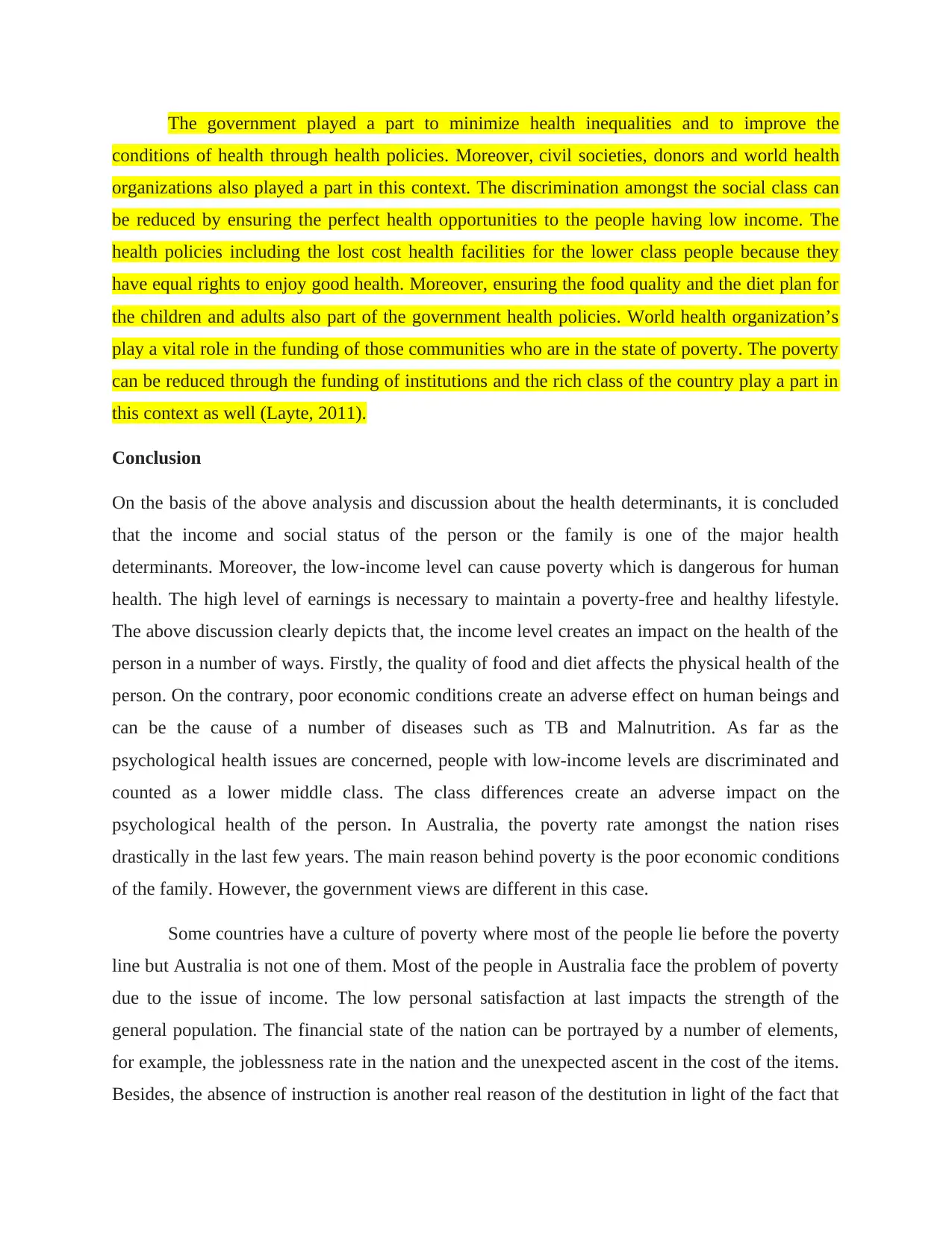
The government played a part to minimize health inequalities and to improve the
conditions of health through health policies. Moreover, civil societies, donors and world health
organizations also played a part in this context. The discrimination amongst the social class can
be reduced by ensuring the perfect health opportunities to the people having low income. The
health policies including the lost cost health facilities for the lower class people because they
have equal rights to enjoy good health. Moreover, ensuring the food quality and the diet plan for
the children and adults also part of the government health policies. World health organization’s
play a vital role in the funding of those communities who are in the state of poverty. The poverty
can be reduced through the funding of institutions and the rich class of the country play a part in
this context as well (Layte, 2011).
Conclusion
On the basis of the above analysis and discussion about the health determinants, it is concluded
that the income and social status of the person or the family is one of the major health
determinants. Moreover, the low-income level can cause poverty which is dangerous for human
health. The high level of earnings is necessary to maintain a poverty-free and healthy lifestyle.
The above discussion clearly depicts that, the income level creates an impact on the health of the
person in a number of ways. Firstly, the quality of food and diet affects the physical health of the
person. On the contrary, poor economic conditions create an adverse effect on human beings and
can be the cause of a number of diseases such as TB and Malnutrition. As far as the
psychological health issues are concerned, people with low-income levels are discriminated and
counted as a lower middle class. The class differences create an adverse impact on the
psychological health of the person. In Australia, the poverty rate amongst the nation rises
drastically in the last few years. The main reason behind poverty is the poor economic conditions
of the family. However, the government views are different in this case.
Some countries have a culture of poverty where most of the people lie before the poverty
line but Australia is not one of them. Most of the people in Australia face the problem of poverty
due to the issue of income. The low personal satisfaction at last impacts the strength of the
general population. The financial state of the nation can be portrayed by a number of elements,
for example, the joblessness rate in the nation and the unexpected ascent in the cost of the items.
Besides, the absence of instruction is another real reason of the destitution in light of the fact that
conditions of health through health policies. Moreover, civil societies, donors and world health
organizations also played a part in this context. The discrimination amongst the social class can
be reduced by ensuring the perfect health opportunities to the people having low income. The
health policies including the lost cost health facilities for the lower class people because they
have equal rights to enjoy good health. Moreover, ensuring the food quality and the diet plan for
the children and adults also part of the government health policies. World health organization’s
play a vital role in the funding of those communities who are in the state of poverty. The poverty
can be reduced through the funding of institutions and the rich class of the country play a part in
this context as well (Layte, 2011).
Conclusion
On the basis of the above analysis and discussion about the health determinants, it is concluded
that the income and social status of the person or the family is one of the major health
determinants. Moreover, the low-income level can cause poverty which is dangerous for human
health. The high level of earnings is necessary to maintain a poverty-free and healthy lifestyle.
The above discussion clearly depicts that, the income level creates an impact on the health of the
person in a number of ways. Firstly, the quality of food and diet affects the physical health of the
person. On the contrary, poor economic conditions create an adverse effect on human beings and
can be the cause of a number of diseases such as TB and Malnutrition. As far as the
psychological health issues are concerned, people with low-income levels are discriminated and
counted as a lower middle class. The class differences create an adverse impact on the
psychological health of the person. In Australia, the poverty rate amongst the nation rises
drastically in the last few years. The main reason behind poverty is the poor economic conditions
of the family. However, the government views are different in this case.
Some countries have a culture of poverty where most of the people lie before the poverty
line but Australia is not one of them. Most of the people in Australia face the problem of poverty
due to the issue of income. The low personal satisfaction at last impacts the strength of the
general population. The financial state of the nation can be portrayed by a number of elements,
for example, the joblessness rate in the nation and the unexpected ascent in the cost of the items.
Besides, the absence of instruction is another real reason of the destitution in light of the fact that
Paraphrase This Document
Need a fresh take? Get an instant paraphrase of this document with our AI Paraphraser
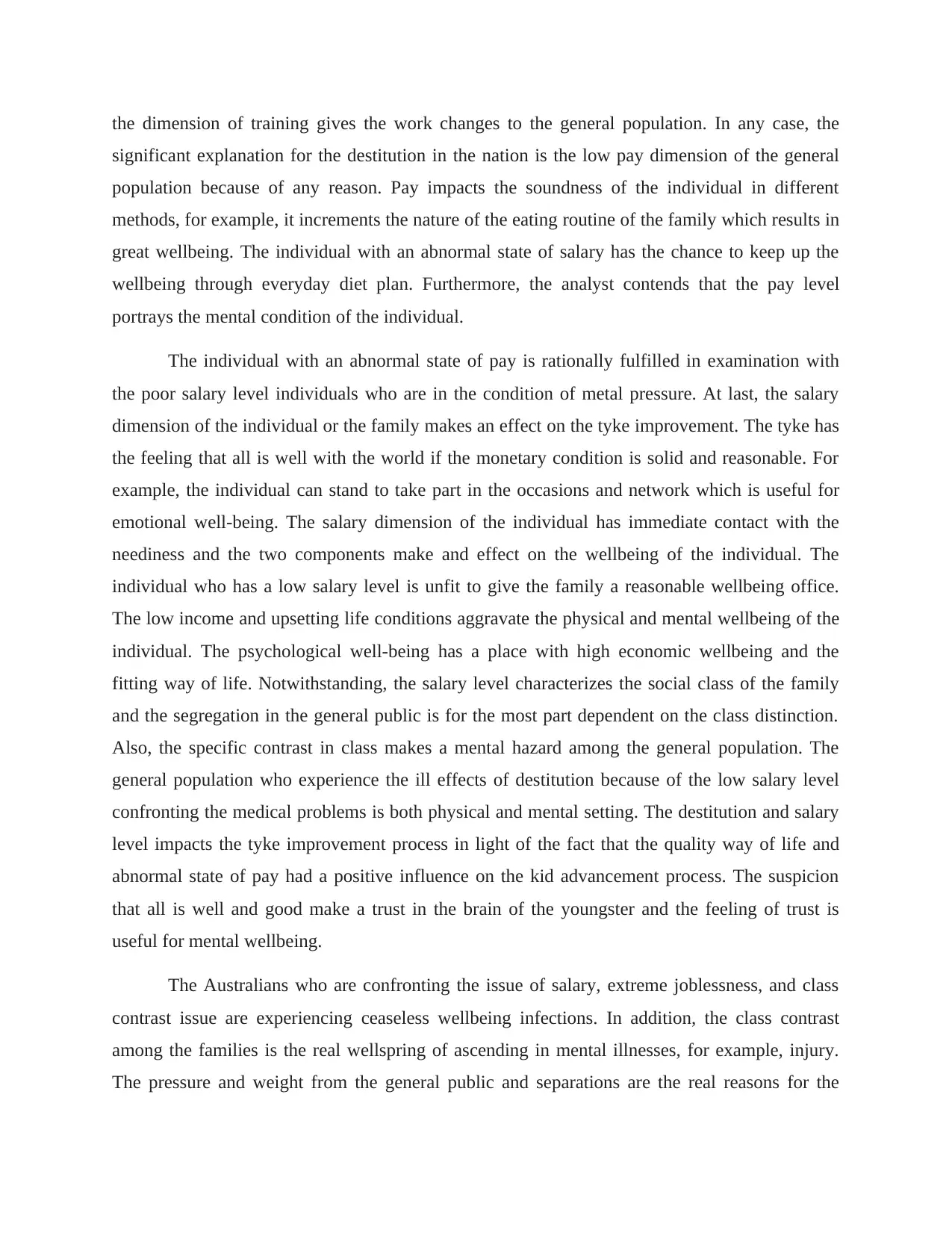
the dimension of training gives the work changes to the general population. In any case, the
significant explanation for the destitution in the nation is the low pay dimension of the general
population because of any reason. Pay impacts the soundness of the individual in different
methods, for example, it increments the nature of the eating routine of the family which results in
great wellbeing. The individual with an abnormal state of salary has the chance to keep up the
wellbeing through everyday diet plan. Furthermore, the analyst contends that the pay level
portrays the mental condition of the individual.
The individual with an abnormal state of pay is rationally fulfilled in examination with
the poor salary level individuals who are in the condition of metal pressure. At last, the salary
dimension of the individual or the family makes an effect on the tyke improvement. The tyke has
the feeling that all is well with the world if the monetary condition is solid and reasonable. For
example, the individual can stand to take part in the occasions and network which is useful for
emotional well-being. The salary dimension of the individual has immediate contact with the
neediness and the two components make and effect on the wellbeing of the individual. The
individual who has a low salary level is unfit to give the family a reasonable wellbeing office.
The low income and upsetting life conditions aggravate the physical and mental wellbeing of the
individual. The psychological well-being has a place with high economic wellbeing and the
fitting way of life. Notwithstanding, the salary level characterizes the social class of the family
and the segregation in the general public is for the most part dependent on the class distinction.
Also, the specific contrast in class makes a mental hazard among the general population. The
general population who experience the ill effects of destitution because of the low salary level
confronting the medical problems is both physical and mental setting. The destitution and salary
level impacts the tyke improvement process in light of the fact that the quality way of life and
abnormal state of pay had a positive influence on the kid advancement process. The suspicion
that all is well and good make a trust in the brain of the youngster and the feeling of trust is
useful for mental wellbeing.
The Australians who are confronting the issue of salary, extreme joblessness, and class
contrast issue are experiencing ceaseless wellbeing infections. In addition, the class contrast
among the families is the real wellspring of ascending in mental illnesses, for example, injury.
The pressure and weight from the general public and separations are the real reasons for the
significant explanation for the destitution in the nation is the low pay dimension of the general
population because of any reason. Pay impacts the soundness of the individual in different
methods, for example, it increments the nature of the eating routine of the family which results in
great wellbeing. The individual with an abnormal state of salary has the chance to keep up the
wellbeing through everyday diet plan. Furthermore, the analyst contends that the pay level
portrays the mental condition of the individual.
The individual with an abnormal state of pay is rationally fulfilled in examination with
the poor salary level individuals who are in the condition of metal pressure. At last, the salary
dimension of the individual or the family makes an effect on the tyke improvement. The tyke has
the feeling that all is well with the world if the monetary condition is solid and reasonable. For
example, the individual can stand to take part in the occasions and network which is useful for
emotional well-being. The salary dimension of the individual has immediate contact with the
neediness and the two components make and effect on the wellbeing of the individual. The
individual who has a low salary level is unfit to give the family a reasonable wellbeing office.
The low income and upsetting life conditions aggravate the physical and mental wellbeing of the
individual. The psychological well-being has a place with high economic wellbeing and the
fitting way of life. Notwithstanding, the salary level characterizes the social class of the family
and the segregation in the general public is for the most part dependent on the class distinction.
Also, the specific contrast in class makes a mental hazard among the general population. The
general population who experience the ill effects of destitution because of the low salary level
confronting the medical problems is both physical and mental setting. The destitution and salary
level impacts the tyke improvement process in light of the fact that the quality way of life and
abnormal state of pay had a positive influence on the kid advancement process. The suspicion
that all is well and good make a trust in the brain of the youngster and the feeling of trust is
useful for mental wellbeing.
The Australians who are confronting the issue of salary, extreme joblessness, and class
contrast issue are experiencing ceaseless wellbeing infections. In addition, the class contrast
among the families is the real wellspring of ascending in mental illnesses, for example, injury.
The pressure and weight from the general public and separations are the real reasons for the
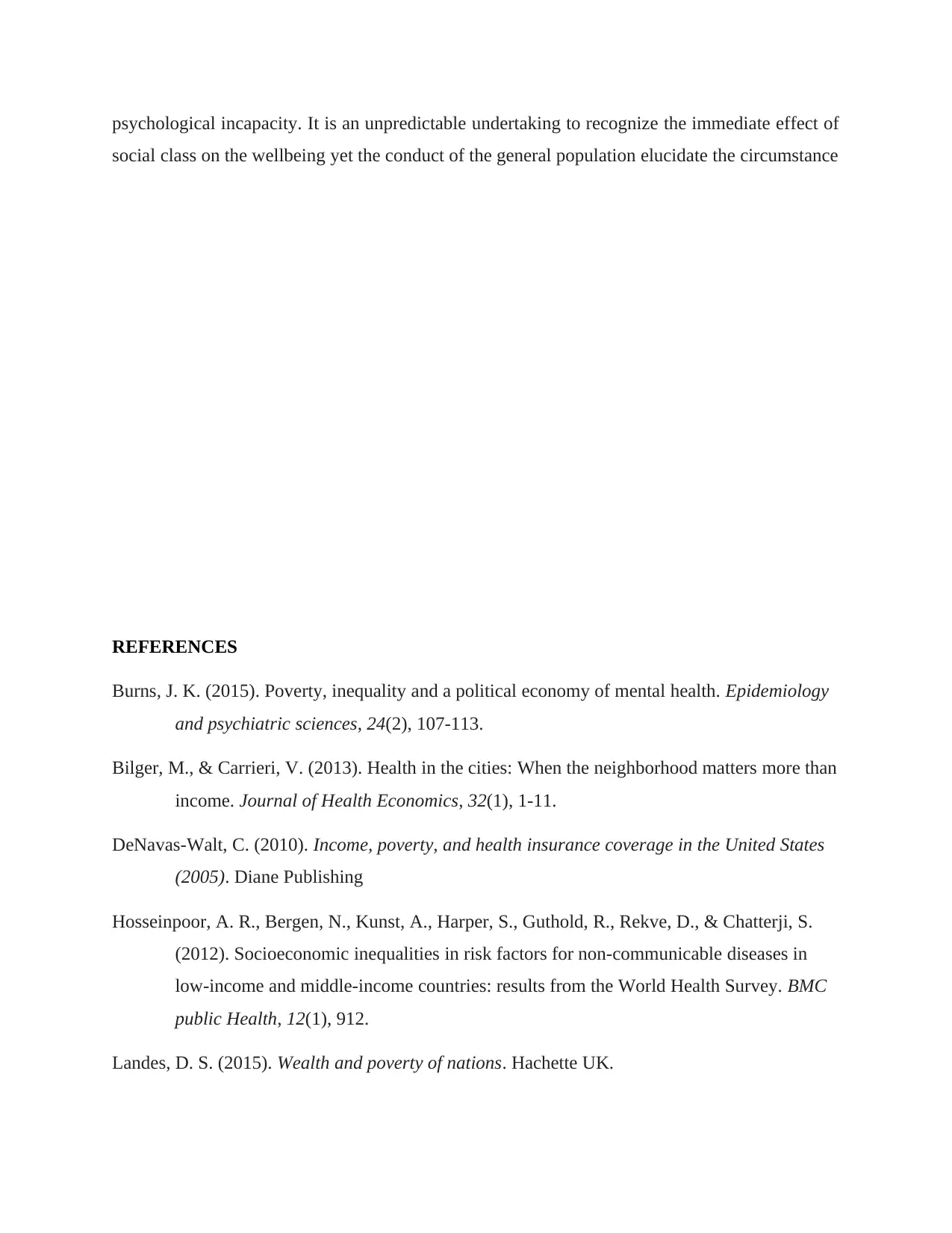
psychological incapacity. It is an unpredictable undertaking to recognize the immediate effect of
social class on the wellbeing yet the conduct of the general population elucidate the circumstance
REFERENCES
Burns, J. K. (2015). Poverty, inequality and a political economy of mental health. Epidemiology
and psychiatric sciences, 24(2), 107-113.
Bilger, M., & Carrieri, V. (2013). Health in the cities: When the neighborhood matters more than
income. Journal of Health Economics, 32(1), 1-11.
DeNavas-Walt, C. (2010). Income, poverty, and health insurance coverage in the United States
(2005). Diane Publishing
Hosseinpoor, A. R., Bergen, N., Kunst, A., Harper, S., Guthold, R., Rekve, D., & Chatterji, S.
(2012). Socioeconomic inequalities in risk factors for non-communicable diseases in
low-income and middle-income countries: results from the World Health Survey. BMC
public Health, 12(1), 912.
Landes, D. S. (2015). Wealth and poverty of nations. Hachette UK.
social class on the wellbeing yet the conduct of the general population elucidate the circumstance
REFERENCES
Burns, J. K. (2015). Poverty, inequality and a political economy of mental health. Epidemiology
and psychiatric sciences, 24(2), 107-113.
Bilger, M., & Carrieri, V. (2013). Health in the cities: When the neighborhood matters more than
income. Journal of Health Economics, 32(1), 1-11.
DeNavas-Walt, C. (2010). Income, poverty, and health insurance coverage in the United States
(2005). Diane Publishing
Hosseinpoor, A. R., Bergen, N., Kunst, A., Harper, S., Guthold, R., Rekve, D., & Chatterji, S.
(2012). Socioeconomic inequalities in risk factors for non-communicable diseases in
low-income and middle-income countries: results from the World Health Survey. BMC
public Health, 12(1), 912.
Landes, D. S. (2015). Wealth and poverty of nations. Hachette UK.
⊘ This is a preview!⊘
Do you want full access?
Subscribe today to unlock all pages.

Trusted by 1+ million students worldwide
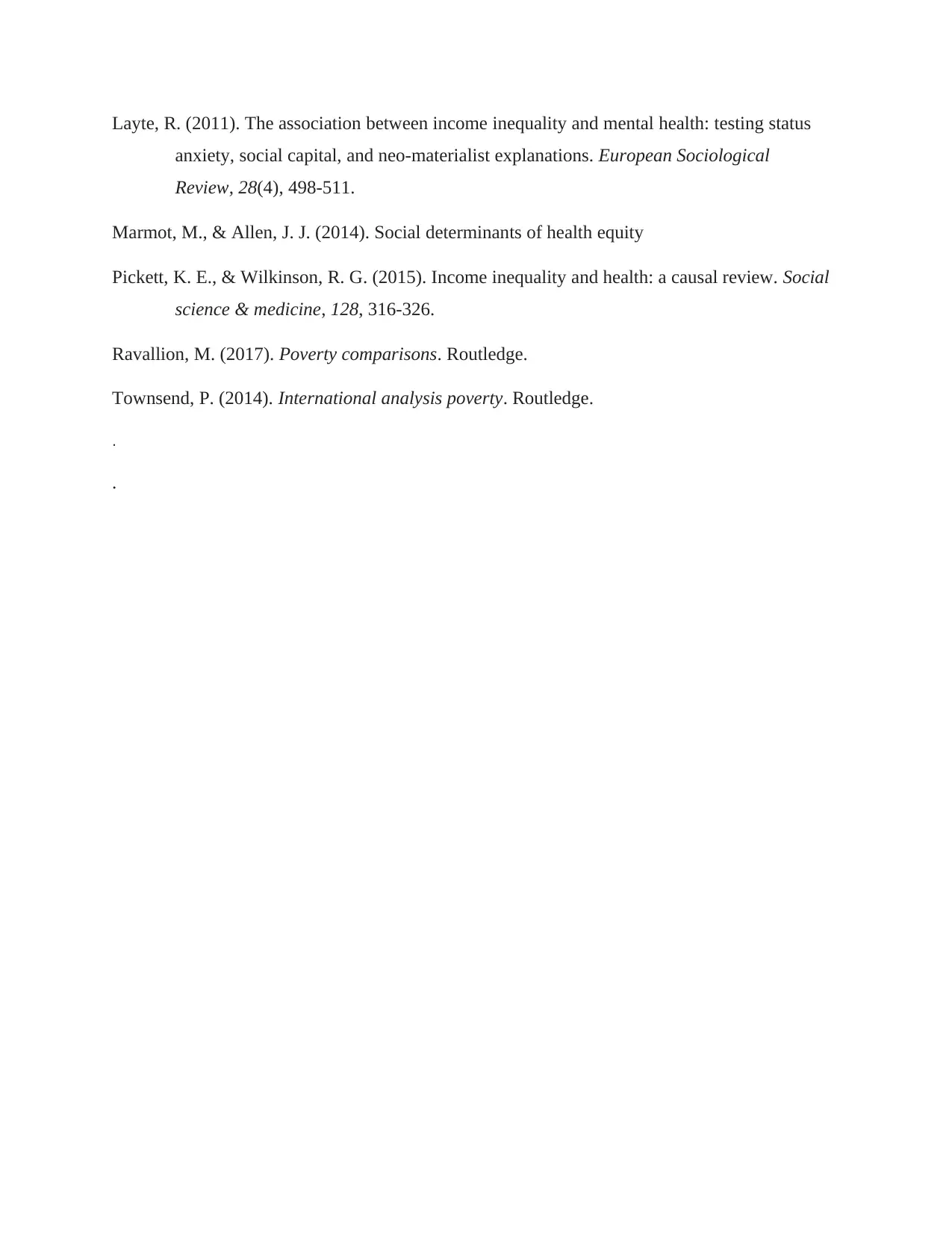
Layte, R. (2011). The association between income inequality and mental health: testing status
anxiety, social capital, and neo-materialist explanations. European Sociological
Review, 28(4), 498-511.
Marmot, M., & Allen, J. J. (2014). Social determinants of health equity
Pickett, K. E., & Wilkinson, R. G. (2015). Income inequality and health: a causal review. Social
science & medicine, 128, 316-326.
Ravallion, M. (2017). Poverty comparisons. Routledge.
Townsend, P. (2014). International analysis poverty. Routledge.
.
.
anxiety, social capital, and neo-materialist explanations. European Sociological
Review, 28(4), 498-511.
Marmot, M., & Allen, J. J. (2014). Social determinants of health equity
Pickett, K. E., & Wilkinson, R. G. (2015). Income inequality and health: a causal review. Social
science & medicine, 128, 316-326.
Ravallion, M. (2017). Poverty comparisons. Routledge.
Townsend, P. (2014). International analysis poverty. Routledge.
.
.
1 out of 10
Related Documents
Your All-in-One AI-Powered Toolkit for Academic Success.
+13062052269
info@desklib.com
Available 24*7 on WhatsApp / Email
![[object Object]](/_next/static/media/star-bottom.7253800d.svg)
Unlock your academic potential
Copyright © 2020–2025 A2Z Services. All Rights Reserved. Developed and managed by ZUCOL.





